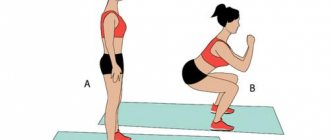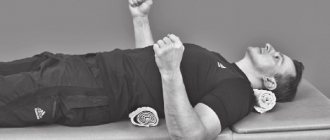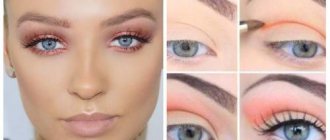There is no point in talking about whether exercises will help or not to improve vision. If you undertake to do them, you need to believe that everything you do will be beneficial and will make your vision sharper and your life easier.
This is the only way to achieve tangible success.
Among those who promote exercise to restore vision, there is not a single person whom they have not helped, including your humble servant. But the fact is that all participants believed in a positive result.
Important! Ordinary, simple at first glance, exercises can significantly improve our vision in many cases without medications or expensive surgeries. You just have to believe in what you are doing. The most effective is often the simplest.
Why do you need eye exercises?
Therapeutic exercises for the eyes are necessary primarily to prevent vision from deteriorating. Every day we are faced with a huge amount of information, we visually study it, but time passes and our eyes lose their former vigilance.
In this way, you can seemingly significantly damage your own vision in a short period of time. You will have to use correction means: glasses and contacts.
Without a doubt, the best treatment is prevention.
. Take care of your eyes today. Eye gymnastics has proven itself to be an effective remedy used for these purposes. It should be done in case of prolonged visual strain, for example, if you read or work at a computer.
It should be remembered that gymnastics will be effective only for minor disorders that are associated with reloads or, on the contrary, relaxation of the eye muscles. It is not possible to correct severe problems, such as, say, myopia, which is associated with the transformation of the size of the eyeball or the refraction of eye structures using gymnastics.
It is especially useful for children
. Parents are advised to take this issue seriously and teach their child a set of eye exercises. Modern children spend a lot of time in front of the computer and TV. They play games on consoles or mobile phones all day long. All this puts a huge strain on children's eyes. By teaching your child relaxation (Chinese) or restorative gymnastics, you will allow him to maintain eye health longer. It should be done both at school and at home. Parents whose children have excellent vision should not underestimate the scale of the problem, since vision is quite fragile and can fail at any time.
Tibetan gymnastics
By regularly performing the exercises of ancient Tibet, spasmodic and organic vision disorders can be eliminated. Many people who regularly performed these activities were eventually able to do without glasses or contact lenses. Tibetans pay special attention to the health of their eyes, as they consider them the most important energy organ. The Tibetan technique is most effective in preventing astigmatism, a pathology associated with a violation of the shape of the lens. It is recommended to combine it with rinsing with cold water, sometimes with the addition of ice cubes. Moreover, the lower the water temperature, the better. Water is poured into a small container, such as a basin. Then the face is completely lowered into it. In water, previously closed eyelids must be opened and rotational actions performed with the eyeballs. After this procedure, the whites will return to their natural whiteness. Even in Eastern medicine, it is believed that the color green can have a beneficial effect. A modern person who is often in front of a computer or engaged in other similar activities should look at green objects more often. Periodically you need to focus your gaze on it for several minutes.

The Tibetan method complex consists of several exercises.
First: you need to hold your hands forty centimeters in front of your face and look at your index fingers, then you should spread your hands to the sides until they can be seen with the help of the peripheral zones of the retina, and then bring them back, still watching them.
Second: looking at your fingers, you should move your gaze to objects located several meters away for five seconds, and then focus your gaze again on your fingers.
Third: closing your eyelids, press your fingertips on your eyeballs six times, then try not to blink for six seconds.
Fourth: we rotate our gaze clockwise, then counterclockwise.
Fifth: for two minutes in a row you need to blink very often, without squinting your eyes too much.
Sixth: stroke the eyelids from the inner corners to the outer ones and vice versa nine times.
At the end of the workout, you just need to sit for a few minutes with your eyelids closed.
Gymnastics exercises for the eyes
Gymnastics can correct some vision problems; let’s look at some effective exercises. But first, let’s make a reservation that morning exercises for the eyes will allow you to immediately tone them up. It is useful and doctors recommend starting your day with a light warm-up for your eyesight.
Exercises can be very simple: blink, rub your eyes with your hands, rotate them, close your eyes tightly and open them, etc.
You can see how to do this exercise for the eyes on the Internet; there are also corresponding photos of the exercises; you can print them out and hang them over your bed so you don’t forget about your exercises.
There is a special complex for glaucoma. Let us remember that this disease is associated with an increase in intraocular pressure, which affects the optic nerve, and subsequently this can lead to blindness. Eye exercises for this disease are mainly aimed at strengthening the muscles inside the eye.
Health-improving exercises are performed daily, each exercise is repeated 4 times.
To relieve fatigue, massage the eyelids of your closed eyes. You should start from the inner edge, moving towards the outer.
Sit down, keep your back straight, look ahead and slowly open and close your eyes with your palms.
A game of blind man's buff will help a lot: close your eyes tightly for 5 seconds, then open them wide. You should perform this exercise 8 times in total.
For myopia
in the early stages of its development, relaxing gymnastics will help greatly, which should be used during prolonged eye strain. For example, if you spend a lot of time at the computer at work.
Cataracts, which mainly affect people over 50 years of age, require regular time for exercise.
Although the disease is usually treated with surgery, in the early stages doctors try to avoid surgery and prescribe conservative treatment: pills, exercises, drops. An ophthalmologist will help you choose the right product.
Today, many people are interested in plastic surgery, which involves a number of rehabilitation procedures, for example, after blepharoplasty
it is recommended to do . Doctors have developed a special complex recommended for implementation during this period. This will help avoid many complications, such as ectropion.
Hello, dear readers of the health portal Vkorale.RU.
Today there will be a short note about something important! About how to preserve and restore vision!
I have previously written about vision in these articles:
But it was about nutrition (about what you should eat and what you shouldn’t. For example, potato chips are not the best option for proper nutrition) and the use of Coral Club products, and in this article we will talk about gymnastics for the eyes. T.K. it is necessary and without it vision cannot be restored.
Universal exercises
The most popular exercises in this category are the following:
- Inhaling deeply, raise your gaze to your eyebrows, hold it there for a few seconds, and as you exhale, lower your gaze down and close your eyes . Repeat ten times.
- Imagine that in front of you is an imaginary mechanical watch. Without turning your head, look at any of the numbers, then look at the center of the clock. Repeat this with each number clockwise, and then do the same counterclockwise.
- Move your eyes as far to the right as you inhale.. Then exhale and return to the original position. Next, repeat the action for the opposite side. Do this a total of ten times.
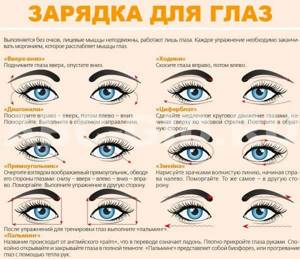
Exercise for the eyes
There are a few important principles to remember when working with your eyes:
- The most important thing for the eyes is rest! To rest your eyes, you need to palm or blink quickly.
- Each exercise should be done in both directions for 4 repetitions, no more, no less.
- Better more often, but less, than less often, but more! That is, it is better to do exercises 5 times a day for 3 minutes than 1 time a day, but for 15 minutes!
Now let's move on to the exercises:
1. Each time, eye exercises begin with palming.
To do this, we rub our palms together and place them on our eyes so that our fingers cross on our forehead and our palms cover our eyes.
2. Eye exercises
I won't describe it. The image below shows everything. The main thing is to follow the rules: do not overstrain your eyes, blink periodically to lubricate your eyes.
3. All gymnastics ends with palming again!
All! =)) These 5-minute breaks for eye exercises can help preserve and restore your vision!
I wish everyone well and a clear outlook!
Did you like the material? Do a good deed - share with your friends on social networks!
Technique for performing eye exercises for myopia and farsightedness. Charging and exercises for children.
Gymnastics for the eyes is a set of special exercises aimed at preserving vision and relieving fatigue. Such exercises are not only useful for myopia and people with reduced vision, but also for office workers who spend most of their work in front of a monitor.
How to do eye exercises for astigmatism?
Exercises for astigmatism are aimed at relaxing various groups of eye muscles. Imagine that there is a cross hanging on the wall in front of you. Move your gaze along its lines, first up and down, and then left and right. After this, “draw” a circle in the air, sliding around the circle in different directions. Repeat this exercise with an infinity sign or a figure eight. Each of them is performed 5-6 times.
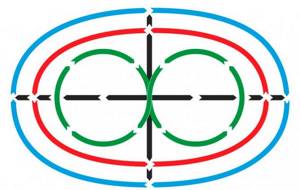
Beneficial properties of gymnastics for the eyes
The whole complex is very simple, you need to do the exercises for 3-5 minutes twice a day. At the same time, you will not only relieve fatigue, but also be able to get rid of many problems that, it would seem, have nothing to do with vision at all.
The benefits of eye exercises are as follows:
- Relaxes
. This is especially important in preschool and school age, when it is necessary to absorb a huge amount of information. With translational and rotational movements of the eyes, the person performing the exercise abstracts from what is happening. He seems to be relaxing. Accordingly, after exercise, nervousness and anxiety disappear. In addition, during exercise, blood circulation in the eyes and brain improves. - Relieves fatigue
. When performing exercises, a person switches from the monotonous strain of vision when reading. When massaging the eyeballs, the nerve endings relax. - Stimulates the functioning of the tear ducts
. Accordingly, after gymnastics, the dryness of the mucous membrane disappears. The pain and burning sensation disappears. - Improves vision
. By improving blood circulation, vision can be improved. This usually occurs with initial myopia in children. - Prevents vision loss
. Due to the constant stimulation of the eyeball, blood flow and massage of the tear ducts, the eyes are moisturized and do not dry out. Beneficial vitamins and oxygen enter the eyes with blood. This is what helps prevent a decrease in visual acuity.
List of exercises
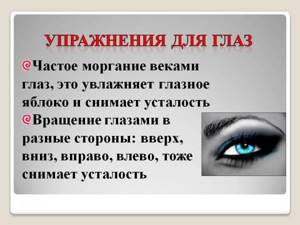
Exercises to improve blood circulation
This category helps you concentrate during the working day and improve your vision sharpness. (What vitamins for the eyes are best to look for here). This includes the following popular techniques:
- “Blinds” - the exercise consists of quickly blinking both eyes for 2 minutes. It should be done easily, without excessive effort.
- Rotation of the pupils clockwise and counterclockwise.
- Move your eyes while inhaling to one side, and while exhaling to the other.
Focus exercises
Indicated for progressive myopia and serves as its prevention. This category includes the following exercises:
- Looking at objects in the distance. To perform it correctly, you need to place a point on the window, select an object in the distance and move your gaze from it to the point and back. Objects need to be selected at different distances.
- Focusing vision on fingers. We bring our right and left hands forward evenly, following our index fingers with our eyes. Hands need to be smoothly moved up, down, brought closer and further away from the face.
- Drawing objects with your eyes. We use our pupils to describe various shapes - circles, eights, diamonds, lines. It is advisable to change them from time to time.
How to determine myopia and farsightedness read the link.
To improve the circulation of intraocular fluid
The most effective exercise of this type is massage. It is carried out as follows: three fingers must be carefully pressed against the upper eyelid and pressed on the eye, holding your hands for several seconds. Repeat 2-3 times during each eye exercise.
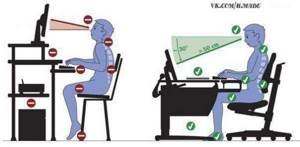
How to sit at the computer correctly
Exercises to relax your eyes
Helps get rid of fatigue during painstaking work at the computer (like computer glasses). This complex contains the following exercise options:
- Drawing with the nose. We sit up straight, close our eyes, and imagine that our nose is a pencil. Which can display letters or pictures. We slowly lower and raise our heads, outlining with them any message you want. The exercise not only helps to relax the eyes, but also relieves fatigue from the neck.
- Through your fingers. We place our arms bent at the elbows in front of our faces, looking through our fingers into the distance and moving our gaze from side to side, without focusing on a specific object.
- Hydromassage. We rinse our eyes in the morning, first with cold water, then with hot water, and in the evening - vice versa. Exercise helps you wake up and also further stimulates blood circulation.
- Picture. We close our eyes for a few minutes, imagining some pleasant picture. The exercise can be made more effective by placing warm palms on your forehead.
- Palming. We close our eyes with our hands so that sunlight does not penetrate through our fingers. We put our elbows on the table and spend a few minutes in this position, thinking about something good. After two minutes, gradually remove your hands so that your eyes can get used to the sunlight.
Complex for work
Such exercises by themselves, even if performed regularly, do not promise the desired effect. Like any other gymnastics, this one must be done in complexes. How to create such a program? The set of exercises can be arbitrary. Its universal version is:
- We do eye hydromassage.
- Let's do the curtain exercise.
- We draw with the nose or pupils.
- We conduct an exercise on focusing on choice.
- We finish the gymnastics by palming or looking through our fingers.
If you want to get the maximum effect from your exercises, be sure to consult a doctor.
The specialist will select the ideal complex for you, the results of which you will be able to evaluate in the near future.
You can read about the types of tables for testing vision at an ophthalmologist in the article Ophthalmic tables for testing vision.
Treatment of adenoviral conjunctivitis in infants:
Read all about lacrimation, causes and treatment in this article.
Contraindications for eye exercises
Despite the benefits of eye exercises, some patients should forget about the procedure. There are diseases that will progress while doing gymnastics.
Contraindications to charging are as follows:
- Retinal detachment
. With this disease, the retina is separated from the choroid. After performing gymnastics, the vessels work more actively, this can be considered the cause of decreased vision as a result of retinal separation. - Inflammatory eye diseases
. You should not do exercises if you have blepharitis and conjunctivitis. Mucus and tear fluid contain pathogens that you can transfer to other parts of the face and spread over the entire surface of the eye. - Rehabilitation after surgery
. If you have recently had laser vision correction or had your lens replaced, you should stop doing gymnastics. By stimulating blood circulation, you risk causing bleeding and sutures (if any were placed) coming apart.
Eye exercises to improve vision - are they effective?
Eye exercises are especially useful for children and those whose work involves excessive visual stress. The benefits of eye exercises for vision have already been proven. At the same time, gymnastics is useful for various refractive errors - myopia, farsightedness, astigmatism, and also as a preventive measure against visual impairment.

In general, almost any eye exercise is aimed at achieving the following effects:
- relaxation of the eye muscles;
- elimination of signs of nervous spasm and asthenopia - rapid eye fatigue;
- restoration of visual acuity;
- improved focusing;
- stimulation of the lacrimal glands;
- normalization of blood circulation in the eyeballs.
This helps prevent the development of various diseases, including dry eye syndrome. Moreover, eye exercises to improve vision help stop the progression of visual pathology.
A set of exercises is selected together with an ophthalmologist, especially if you already have vision problems. Today, quite a lot of techniques have been developed. The patient needs to choose one that will not harm or be useless.
Let's find out which exercises are considered the most effective.

Eye gymnastics technique for adults
There are several methods of eye gymnastics. The set of exercises depends on visual acuity and the presence of diseases. You can perform the simplest complexes to relieve tension and fatigue.
Eye exercises to improve vision
A set of simple exercises mainly consists of blinking, moving the eyeballs and massaging the eyelids. There are many exercises to relieve fatigue and improve vision by Zhdanov, Norbekov and Tibetskikh. All of them are aimed at supplying the eye with a sufficient amount of blood and nutrients. The complex described below is a collection of exercises from ophthalmologists.
Method of performing universal exercises to improve vision:
- Blinkers
. The exercise is very simple to do. You need to squeeze your eyelids tightly, and then open them and blink very quickly for 1-2 minutes. The procedure is aimed at improving blood flow to the eyelids and eyeball. - Zhmurki
. Sit on a chair or sofa, straighten your back, close your eyes with effort and sit like that for 3-5 seconds. Repeat the manipulation 7-10 times. If this is your first time doing the complex, you can reduce the number of repetitions to five. This exercise improves the tone of the eye muscles and strengthens the eyelids. - Swimming
. Stand straight, hands at your sides. Close your eyes for 3 seconds. Open your eyelids and look into the distance for 10 seconds. Place your finger opposite the bridge of your nose at a distance of 35 cm and sharply look at it. Repeat the procedure 7-12 times. This manipulation helps to train the muscular system. - Massage
. A very simple exercise that needs to be done after washing your hands with soap. Do not touch the eyelids and mucous membranes with dirty hands. Close your eyelids, massage the upper skin fold with your little finger from the inner corner of the eye to the outer. In the area of the lower fold, perform circular movements from the outer part of the eye to the inner. - In queue
. This exercise trains the eye muscles individually. You need to take a vertical position and extend your index finger at the level of the bridge of your nose. The distance from the nose to the palm should be 30-35 cm. Look at the tip of your finger for 5-7 seconds. Close your right eye and look at your palm with one eye for another 5-7 seconds. Open your eye and cover your left eye with your palm. Repeat the manipulation 12 times. - Wings
. The exercise is so called due to the fact that when performing it you need to spread your arms like wings. Stand upright and raise your arms, bent at the elbows, so that they are parallel to the floor. Extend the index finger of your right hand and gradually straighten your elbow. At the same time, watch the movement of your finger. Return your hand to its original position without taking your eyes off it. Do the same on the other side (left hand). Repeat the manipulation 7-10 times. - Pressing
. Sit on a chair. Place three fingers connected to each other on each eye. Press on your eyes for 2 seconds. Repeat 7 times. Helps improve fluid circulation inside the eyeball. - Vertical
. Take a vertical position, raise both arms up. Now move your arms straight in front of you at chest level. Lower your right and left arms in turn. Remember to follow the movements of the limbs with your eyes. This trains the vertical muscles and improves coordination. - Watch
. Sit on a chair and bring your right arm bent at the elbow in front of you. Extend your index finger and rotate your hand in a clockwise direction. Follow your pupils with your finger. Repeat the same with your left hand. This exercise helps improve the functioning of the vestibular system and increases attention. - Falls
. Stand with your feet shoulder-width apart. Close your eyes and then open them. Without moving your neck and head, lower your gaze downwards, as if casting it away. Then look up sharply. Repeat the movements 7-12 times. This way you train complex eye movements. - Pendulum
. Take an upright position. Now perform the movements as in the previous exercise, only after your eyes are below, move your gaze to the right and left. Repeat 10 times.
Gymnastics for the eyes for myopia
Myopia is a defect of the visual apparatus in which the image is formed not in the retina, but in front of it. That is, a person sees only very close, bringing an object to his face. Typically, this disease can be combated with laser correction. Patients are often prescribed glasses or contact lenses. But by spending just 20 minutes a day on your eyes, you can improve your visual acuity without surgery or glasses.
Method of performing eye exercises for myopia:
- Blink quickly while squeezing your eyelids tightly
. When opening your eyes, do it with maximum tension. You need to do 5-10 repetitions. Increase the number of blinks every day. - Eights
. Open your eyes and move your eyeballs around the perimeter of the figure eight. You should draw a figure eight with your pupils. Close your eyelids and repeat the exercise with closed eyelids. - Vertical
. Open your eyes wide and move them from top to bottom, describing a vertical line. Movements should be frequent and the scope should be small. The line should be as long as a face. - Horizontal
. Perform oscillatory movements with your eyes from side to side. You should get something similar to the movement of a cat in a watch. The span should also be small, the length of the line should be approximately 15-20 cm. - Circles
. Open your eyes and describe a circle with them. To begin with, you can draw a circle with a diameter of 15 cm and describe it clockwise and counterclockwise. After this, close your eyelids and repeat the exercise. - Hammer
. The exercise is reminiscent of an examination by a neurologist. Extend your right hand in front of you and gradually move your index finger closer to your face. It is necessary to touch the nose with it, while the finger must be accompanied by the gaze. If you start seeing double before you touch your nose, stop the activity. You need to repeat it 10 times a day. - Pressure
. Place the index fingers of both hands in the area above the eyebrows and lift them up. Close your eyes and lie there for 3 seconds. 10 repetitions are required. This puts pressure on your eyelids, improving muscle function. - Diagonal
. Move your eyes from the ear to the chin, you will get oblique lines. Change the direction, you must immediately perform movements from the right ear, and then from the left. Do 7 repetitions in total for each eye.
Gymnastics for eyes with farsightedness
Farsightedness is a disease characterized by the fact that the image is formed behind the retina. At the same time, the eye muscles are often tense, which causes headaches and anxiety. With age-related farsightedness, there is no pain, and older people see well into the distance, the eye muscles are relaxed. You can fight the disease with glasses, surgery or special gymnastics.
Method of performing eye exercises for farsightedness:
- Pendulum
. Take a pencil and extend your hand. It is necessary that the rod is at the level of the nose. Now gradually swing the pencil left and right. Follow the subject with your gaze and gradually move the pencil closer to your face. - Candle
. Exercises with light and darkness are very useful for farsightedness. The activity must be done in the dark. Take a candle and light it, watch the flame. The exercise is performed while sitting on a chair. Without taking your eyes off the flame, turn the body 90 degrees. - Eyebrow massage
. Sit on a chair and straighten your back. Place your index fingers on the head of your eyebrows and make circular movements. You need to do 5 repetitions in total. - Letters
. Use bright lipstick to put a dot on your nose. With your eyes open, move your nose, describing some letters. You can “write” your name. Now close your eyelids and repeat the exercise. - Surveillance
. The exercise is performed outdoors. You need to find a moving object and follow it. An airplane or birds are suitable as an object for observation. - Tilts
. Sit comfortably and cover your right eye with your palm. Tilt your head first to one shoulder, then to the other. Repeat the movements, covering the other eye with your palm. When performing an activity, focus your gaze on some object. - Circles
. The exercise is quite simple, but unlike the exercise that is performed for myopia, you need to guide not with your eyes, but with your chin. You need to draw a circle with your face, focusing your gaze on any object that is directly in front of your eyes. Close your eyelids and repeat the exercise.
Palming according to W. G. Bates
Before you start gymnastics, you need to properly prepare yourself for this. Just like in sports, you cannot come from home to the gym and immediately take on a heavy weight on your chest. There will be zero effect, and you risk tearing your muscles, straining your back or getting a hernia. It’s the same with the visual apparatus. It must be properly prepared before moving on to a block of effective and complex exercises.
Ophthalmologists have developed a small complex that allows you to relax your eyes and properly prepare them for subsequent stress on the muscles during gymnastics. Palming is an essential part of any gymnastics to restore vision.
Video eye trainer based on the William Bates technique:
Palming is a fairly popular and simple exercise to relax the muscles of the visual apparatus. This exercise uses both palms. The principle of palming consists of the following steps:
- It is necessary to warm up your palms. The best way to do this is to rub them together until they are slightly red and hot.
- Fold your palms so that they touch each other with their inner ribs and are located in the same plane.
- Bend your elbows, finding a support point (for example, a table or knees) and close your eyes with your palms so that only the fingers of one hand are on top of the other.
- Spend 5-7 minutes in this position. If necessary, repeat after some time.
The essence of palming is to cause so-called “lightning” in the eyes. However, you should not put pressure on the eyeballs.
This simple exercise can improve vision and is effective for myopia and farsightedness. When palming, the heat from the palms affects the facial nerves, as well as the eye muscles, relaxing them and providing blood flow to them. Such regular training can even change the angle of the eyeball, that is, you can count on a noticeable positive effect even with strabismus. You just need to squeeze your fingers as tightly as possible so that light does not penetrate through them. It is important that when performing palming you need to relax as much as possible, take a comfortable and relaxing position.
At the initial stage of palming, you may experience not entirely pleasant sensations in the eye area, pain and a feeling of pressure “from within”. This is a completely normal condition, and after a few exercises the discomfort will go away.
Exercise No. 1. I'm writing to you…
Despite the fact that the previous exercise relieved tension from the visual apparatus, the muscles did not completely relax. We'll do just that now. Unfortunately, many people, trying to restore their eyes and relax them as much as possible, forget that the neck is also involved in every exercise, as it also needs attention. It is from the neck area that blood flows to our eyes and thus nutrition is provided. We will try to do everything to bring this process back to normal, after numerous violations while working in front of the monitor. To perform gymnastics, you will need a chair or a mat, as it can be performed in two positions: sitting and lying down.
To achieve the right result from gymnastics you need:
- Take a comfortable position lying or sitting.
- Close eyes
- Relax.
- Imagine that there is a pen attached to the tip of your nose and you urgently need to write a letter.
- Now you can start drawing simple figures or writing whole words, but certainly with your nose, without helping yourself with your hands.
- The neck should also participate in this process.
- First, try writing the entire alphabet.
- Increasing the difficulty, try to reproduce your favorite verse or at least a couple of lines from it.
Exercise No. 2. See through your fingers
Another exercise can relieve fatigue from your eyes. Its implementation is also not limited to a certain pose. You need:
- Bend your elbows.
- Open your fingers.
- Bring your palms to your eyes so that the back of each palm is directly under the eye.
- Now look through your fingers at any objects in the room.
- The most important thing is not to focus on the fingers themselves; the whole point of the exercise is to see something beyond them.
The exercise can be made more difficult by trying to concentrate on objects in the room in motion. Look in different directions, turn around without moving your hands away from your face. Do the exercise about thirty times, spending no more than five seconds on each attempt to see something in the distance. This exercise will seem difficult at first, but over time you will learn to concentrate on individual things without paying attention to your hands.
| Exercise name | lead time | Number of approaches |
| Exercise No. 1 | 30 seconds | 3 approaches |
| Exercise No. 2 | No more than 5 seconds | 3 sets of 10 times |
| Warm-up | 30 seconds | 2 to 3 approaches |
Eye gymnastics for children
Children are a category of patients who often experience visual impairment due to constant tension, so all exercises to restore visual acuity are aimed at alternating tension and relaxation. It is advisable to do gymnastics for 2 minutes every hour while reading or doing homework.
Method of performing eye gymnastics for children:
- Semicircle
. The exercise is performed while sitting on a chair, sharply look away at the ceiling, and then move your gaze to the left. Describing a semicircle, move your eyes to the right across your forehead. You will get an arc over your forehead. - Infinity
. The child should use his gaze to describe an inverted figure eight, that is, an infinity sign. A figure eight is drawn within the face. You can change the activity a little. First, let him move his gaze to the upper right corner, and then to the lower left. Now from the upper left corner you need to move your gaze to the lower right. The result will be something similar to a butterfly. - Strabismus
. A very fun exercise. Focus your gaze on the tip of your nose. Shift your gaze sharply to the right. Repeat the same thing, only selecting the item on the left. - To the sides
. Use your index fingers to touch the tip of your nose and spread them in different directions. Observe the two fingers with your peripheral vision, but do not try to squint your eyes. - Waves
. Describe a wave or sine wave with your eyes. Perform the exercise from right to left and left to right. Repeat 10 times.
How to do eye exercises - watch the video: Such simple exercises will relieve tension and help improve your vision a little.
There is usually an improvement in visual acuity after 6-9 months of regular exercise. The benefits of gymnastics for the eyes Vision is one of the five senses with the help of which a person learns, perceives and explores the world around him.
Causes of visual impairment.
The modern conditions in which children grow up do not allow us to protect them from harmful influences. Cartoons, educational computer games, television - all this is an integral part of the life of a preschooler. We will not talk about the dangers of TV and computers, but will try to adapt to the current circumstances. It is in such conditions that it is necessary to learn to protect your eyesight.
Visual gymnastics is a wonderful assistant in the fight for good vision. The main task of gymnastics for the eyes of preschoolers is to form the correct idea that vision needs to be taken care of. Regular eye exercises improve vision performance, improve blood circulation, and prevent the development of certain eye diseases. In addition, any educational material is absorbed more effectively. Often underestimating the use of visual gymnastics for children can be a serious miscalculation when working with children. In addition, this method is a kind of relaxation for the child’s nervous system and helps the brain better process information received through vision. When introducing simple eye gymnastics exercises to children, teachers should remind them that the child can perform these gymnastics at home. Having acquired the skill of performing visual gymnastics, the child performs it within a few minutes. The child's eyes are resting.
Which children need eye exercises?
Many parents believe that their children, who have 100% vision, are not at risk. Not at all! A child’s vision is a fragile instrument that requires care, attention and – above all – constant monitoring.
Visual gymnastics in preschool educational institutions
Visual gymnastics for the eyes in preschool educational institutions can be carried out in various forms:
- Five-minute game with different objects;
- Use of visual simulators (individual, wall-mounted);
- Reliance on the diagram and visual cues;
- Gymnastics according to verbal instructions, with poems.
Gymnastics for the eyes of a preschooler
Exercises to relieve eye strain:
1.Stand freely, arms along your body. Raise your shoulders as high as possible. Keeping them in this position, move them back as far as possible and return to their original position. Make circular movements with your shoulders. Repeat 10 times.
2. Stand freely, arms along your body. Raise your shoulders as high as possible. Holding them in this position, move them back, then move them forward, lower them, returning to the starting position. Repeat 10 times.
3. Lower your chin to your chest, relax your neck, then lift your head and throw it back as far as possible. Repeat 5-6 times.
4. In a sitting position. Lower your chin to your chest, then smoothly turn your head to the left, tilt it back, and return to the starting position. Repeat 5 times in one direction and 5 times in the other.
5. In a sitting position. Turn your head as far as possible to the left, return to the starting position. Turn your head as far to the right as possible, return to the starting position. Repeat turns 5 times at a slow pace.
A set of exercises for the eyes.
1. Place colored cardboard circles of different sizes in the corners of the room, under the ceiling. Invite the children to look at the left circle for a few seconds, then at the right one, do this exercise 3-5 times, make sure that only the children’s eyes are working, after 3-5 exercises close their eyes for 10 seconds, repeat the exercise 3 times.
2. To relax the muscles that support the eyeball, it is suggested to close and relax your eyes for 10 seconds.
3. To perform the following visual gymnastics exercise for children, place your hands under the chin to prevent head movement. The child should raise his eyes and look up, then down 4 times, break 10 seconds, then right, left 4 times, break 10 seconds. 4. Finding toys in the group space; fixation of gaze on an object.
We invite children to find the toy with their eyes. Examine it for 5-7 seconds.
5. Exercise “Mark on glass” (a small silhouette of a toy can act as a mark). Look at the mark on the glass from a distance of 30-35 cm for 4-6 seconds. Then move your gaze to the object behind the glass (tree, house, car, etc.) for 4-6 seconds. Then alternately look at the mark and then at the object. Repeat for about 30-40 seconds.
6. Slow blinking for 10 seconds. “The butterflies flew and flapped their wings.” Children flutter their eyelashes.
7. "Let's warm our eyes." Invite the children to rub their palms together and cover their eyes with them (the eyes under the palms are closed). “Let’s rub our palms so they become warm. Let’s close our eyes and put our palms on them, warm our eyes.” (Eyes are closed for 5-10 seconds).
Kids quickly get bored of doing the same exercises. Therefore, you can offer them exercises for the eyes in a playful way.
Set of exercises:
“Fun week”
All week in order, the eyes do exercises. - On Monday, when they wake up, their eyes will smile at the sun, they will look down at the grass and back to the heights.
(Raise your eyes up; lower them down, head motionless).
On Tuesday the eyes watch, They look here and there, They walk to the left, they walk to the right They will never get tired.
(Turn your eyes to the right side and then to the left, head motionless).
On Wednesday we play blind man's buff, close our eyes tightly. One, two, three, four, five, Let's open our eyes. We close our eyes and open it. So we continue the game.
On Thursdays we look into the distance, It’s not a pity for this time, What is near and what is in the distance The eyes must consider.
(Look straight ahead into the distance, then raise your finger at a distance of 30 cm from the eyes and look at it. Repeat several times).
On Friday we didn’t yawn. Our eyes ran around in circles. Stop, and again run in the other direction.
(Rotate your eyes left and right in a circle).
Even if Saturday is a day off, we are not lazy with you. We look for corners, so that the pupils run.
(Look at the upper right corner, then the lower left, then vice versa to the upper left).
We'll sleep on Sunday, and then we'll go for a walk. To harden your eyes, you need to breathe air.
(Close your eyelids, massage them with light circular movements of your fingers).
Without gymnastics, friends, Our eyes cannot live!
For eye gymnastics, you can use physical therapy. minutes, just “follow them with your eyes”:
The fish are frolicking merrily in the clean, warm water, then they squeeze and unclench, and then they bury themselves in the sand. Eyes - fish - close them, open them, close them with your hands and stroke your eyelids with your fingers.
Our delicate flowers open their petals. The breeze breathes slightly, the petals sway. They opened their eyes and looked left and right. They waved their eyelashes.
The finger moves to the nose, and then back, to look at it. We are very pleased! Extend your hand forward. Watch the tip of your finger, slowly bringing it closer to your nose, and then just as slowly moving it back.
Now close your eyes and stroke with your hands, You and I will dream about our beloved mother. Close your eyes, stroke your eyelids.
Gymnastics for the eyes is a training basis for preventive actions for the muscles of the organs of vision. The development of eye muscles will allow the child not to have problems with vision and eye fatigue in the future. The entire comprehensive eye program is designed to:
- normalization of the nervous system;
- improving brain function;
- relieving stress on the optic nerve;
- to prevent vision loss.
Exercises and gymnastics for the eyes can be started for children aged 2-3 years and older. This is the best option for preventing diseases of the visual analyzer.
Complex, daily exercises were developed by ophthalmologists to reduce fatigue and tension in the fundus of the eye and prevent the development of myopia. Eye exercises for children will help prepare for school stress and reduce fatigue and redness of the eyeball. These exercises are necessary in the following cases:
- farsightedness;
- myopia;
- fatigue and overstrain of the optic nerve;
- long periods of time in front of the TV or computer;
- hereditary predisposition to vision loss;
- diseases of internal organs;
- for astigmatism
Before choosing the right method for your eyes, you need to consult an ophthalmologist and choose the more correct option. If there are no contraindications, you can start doing simple, uncomplicated exercises with your child.
Useful eye exercises should be performed every day, gradually increasing and complicating the load. Gymnastics for the child’s eyes should be carried out for 3-5 minutes twice a day. To ensure that the child does not forget and does the exercises correctly, the set of exercises is best done with parents. You can perform eye exercises by alternating mental and physical activity, with strict control of the child’s presence in front of a computer monitor, which is a negative factor that negatively affects eye health.
What eye exercises are useful for farsightedness?
The following exercises help stop the development of hypermetropia:
- stand or sit straight and slowly turn your head left and right, moving your gaze in the appropriate direction;
- take a pencil, place it at a distance of 30 cm from your face and look at its tip for 5-10 seconds, then
- move your gaze to a distant object behind the pencil.
After gymnastics, perform self-massage of the neck and back of the head.

Types of exercises
The method of gymnastic exercises for children’s eyes is divided into two complexes. It can be artistic, when all the exercises are carried out orally in the form of a story or poem, which is more popular with younger children. At school, you can conduct small physical education sessions during lessons, which will not only help preserve children’s vision, but will also distract them a little from tedious activities, thereby having a significant impact on the development of memory and attention. This action will not only be of interest, but also the benefits of gymnastics for the eyes. After doing the exercises, you can rub your eyes a little and blink - this will help relax the optic nerve.
The second type of lessons takes place using various auxiliary objects, such as pencils, cards, dividing lines drawn on a board or pieces of paper, the outline of which the child must repeat with his eyes. It takes 30 seconds to draw such lines and perform the action with your eyes. You can correct and improve your vision by using the computer program “PowerPoint,” which was specially designed for such purposes. This option will be able to interest the child and help him perform the necessary exercises every day.
All visual exercises can be changed and adjustments made to them, adding new gaming techniques. You can perform such exercises for children at school and at home. Thus, daily performance of useful eye exercises will help prevent the development of serious eye diseases in children, adolescents and adults.
Popular methods of vision restoration
A number of proprietary techniques have been developed to maintain eye health. They all have their own specifics and specific execution techniques. Such eye gymnastics are effective for myopia (myopia), and for cataracts, eye gymnastics allows you to “postpone” surgical treatment indefinitely if you start training on time.

Gymnastics for the eyes according to Norbekov
Dr. M. Norbekov not only proposed a variety of exercise therapy complexes for skeletal muscles, he did not ignore the organ of vision.
- Focus your gaze on the tip of your nose, then smoothly move it into the distance. Without moving your eyeballs, try to see objects in your field of vision as clearly as possible.
- Place the index fingers of both hands at eye level. Spread them apart, trying to keep both fingers in sight.
- Imagine before your eyes a large hour dial with drawn numbers. Take turns looking at each number in forward and then reverse order.
All tasks are performed 5 times, first with eyes open, then with eyes closed, and finally, just mentally.
Exercises according to Zhdanov
The basis of Professor V. G. Zhdanov’s technique is drawing various geometric shapes with the eyes. It includes:
- Consecutive movements of the eyeballs up and down, left and right, clockwise and counterclockwise.
- Drawing a rectangle, a cross.
- Movement of the eyeballs in a spiral and “snake”.
- Image through the eyes of a figure eight in the horizontal and vertical planes.
Each figure needs to be drawn 6-10 times, blinking quickly in between, giving your eyes a rest.
Tibetan gymnastics
The Tibetan technique is performed in the morning, immediately after waking up.
- Close your eyes tightly and open your eyes wide several times.
- Lower your eyelids and press lightly with your fingertips.
- Try to open your eyes, leaving your fingers on your eyelids to provide resistance.
- Place your index finger on the tip of your nose, then move it further forward, following with your eyes.
- Blink continuously for 30 seconds.
- Rinse your face with cool water and lie down with your eyes closed for a few minutes.
All tasks are completed 5-8 times.



